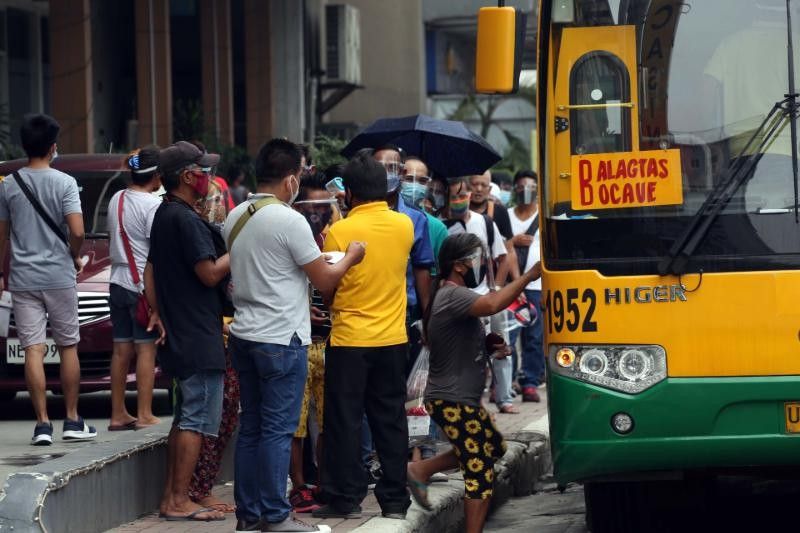Service contracting scheme for public transportation gets IATF green light

MANILA, Philippines — Almost half a year into the coronavirus pandemic, the government's coronavirus task force has finally adopted the service contracting scheme for public transport, the Department of Transportation disclosed Monday.
This comes after the department drew flak from no less than the Department of Health, which chairs the Inter-Agency Task Force on Emerging Infectious Diseases, for its new policy of reducing the required physical distancing in public transportation.
Transportation officials said that the move was in response to grievances on the state of mass transportation amid the community quarantine—calls that have been resounding as early as June—to add more vehicles on the road for commuters.
In a statement issued Monday, the DOTr disclosed that the IATF approved the implementation of service contracting of public utility vehicles in Resolution No. 69 — signed the week before on Monday, September 7 — "to subsidize public transport operations, incentivize PUV operators to return, serve commuters, and restore the livelihood of displaced transport workers, among others."
“Due to the limitations imposed on our public transportation, operators and drivers may not be able to sustain their operations. This may lead to inconsistent travel trips causing commuters to compete for rides, while drivers and operators disregard passenger capacity in exchange for more revenue,” said DOTr Assistant Secretary Steve Pastor.
The idea, though, is nothing new as groups like the Move as One transport coalition, a commuter group of transportation economists and advocates, have long lobbied for service contracting in public transportation, where the government pays operators and drivers a per kilometer fee to run the routes and requires compliance to performance standards specified under these contracts.
READ: Coalition proposes P110 billion for 'secure' post-lockdown public transport
Service contract provisions being finalized
Land Transportation Franchising and Regulatory Board chair Martin Delgra also disclosed that performance indicators that will serve as the basis for payment and the preferred mode of payment on these vehicles are being finalized.
Under the forthcoming service contracts, public utility jeepneys and buses are still required to follow the 50% passenger capacity and other safety and health protocols. "They will also have to operate within a set of working hours and must be able to provide available back-up units should there be cases of vehicle breakdowns," the department said.
In addition, a set of qualifications based on road safety has also been prescribed: according to the LTFRB, contractors and drivers must possess a professional driver’s license and must be driving a service unit confirmed by an operator. The LTFRB also added that it "will base payments on the total vehicle-kilometer contracted by the driver and operator, as well as their conformance to adhere to safety standards."
“The new arrangement of service contracts among public transportation will no longer just depend on the number of passengers being carried. We are ensuring that our drivers will be fully compensated for their services, despite the imposed load limitations,” said Delgra.
“To ensure fairness as well, we will be employing a third-party monitoring entity to evaluate the total vehicle-kilometers operated, the reliability of their services, driver and vehicle quality and customer satisfaction,” he also said.
'Jeepneys still insufficient'
It is still unclear how much of the 74,000 jeepney units idled by the suspension of public transportation will be allowed back on the road.
The department added in its statement that public utility vehicles must also pass roadworthiness standards set by the Land Transportation Office, which the DOTr has, over the pandemic, often brought up when asked about the lack of jeepneys on the road. The LTO, however, has not been keen on answering questions about its standards—all this, as the department continues to pursue its jeepney phaseout under its PUV modernization program.
As of this publishing, the transportation department has opened 206 routes for over 17,000 units, a far cry from the original amount according to transport group Piston. Sought for comment by Philstar.com, Piston president Mody Floranda reiterated his group's call for a 100-percent jeepney resumption as opposed to the department's gradual and calculated approach.
“In reality, the distance among passengers inside jeepneys is already less than one meter but this is only because the number of jeepneys plying our roads is insufficient and are even operating at half capacity,” he said of the physical distancing reduction in Filipino. "What we need is for all the jeeps to return in order for commuters to have more rides, even if the physical distancing stays."
- Latest
- Trending































